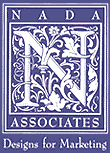|

What is color design?
Color Design is NOT magic, crystal ball gazing, lucky guessing,
or what is "in". Color design takes color beyond the aesthetic
to being an integral part of the marketing plan. Color Design
is a discipline or method of working with, creating or selecting
specific colors to improve the saleability, function or quality
of a product through aesthetics or decorative composition. A professional
color designer understands all that affects a product's color,
from product composition to marketing strategy, and assimilates
this information to provide the most appropriate colors for a
product.
What color is "in" or "hot" or going to be in the next
couple of years?
This is the Number 1 question I am asked!
After 9/11 in America, there is a renewed sense of patriotism and we are currently seeing an increased use of reds and blues in all products, as well as interest in all things Americana. Interestingly enough, both reds and blues were ascending in the marketplace when this catastrophic event catapulted both colours to the forefront of the American psyche. Blue is a peaceful haven -- calming, restful and soothing in a hectic world. Red on the other hand is our passion, our lifeblood, a more aggressive color, one that stands out. Although both hues are important, it is key to get the specific hue and value most appropriate for the product category.
Example: Very bright blues are great
for accent pieces or recreational products, but would be overwhelming
and inappropriate for residential carpeting or a luxury vehicle.
Where do color trends come from and/or why do they change?
My Number 2 all time favorite question. Color doesn't change, rather
consumers attitudes toward color changes. Color trends come from all that
is around us. Since colors cannot be trends unless they sell, consumers
are the only factor in color trends. Consumers, or Society as a whole and
consequently color trends, are reflected in lifestyles and social changes,
politics, travel, art and cultural events, the media and pop culture, the
economy, technology (computer and otherwise), the environment etc. All of
these seemingly diverse influences are filtered, synthesized and channeled
(not the psychic type) into color directions and trends, and are interpreted
into colors that consumers are interested in and accepting of.
Example: Do you remember seeing anything in
Orange five years ago? Look at all the orange that is available now from
clothing to personal care products to home furnishings accessories. The
color didn't change, but your acceptance of it did.
We do our own colors, why would we hire someone to do that for us?
Most companies who create a product's color in-house are leaving
color design decisions generally to non-creative managers who
are doing the color part-time. Since tracking color is a full
time job, they are unable to understand the full realm of factors
influencing color. Color designers spend their entire time in
learning and applying all the nuances of color. Although it may
be true that an employee knows the product inside out, many times
the fresh perspective will bring greater opportunities to the
company's products and markets.
GOOD

Professional color designers break the color barrier in the computer industry. |
NOT SO GOOD

Lawn chairs improperly colored in i-Mac colors will likely be sitting there all season |
Do you guarantee your results?
Although we do not guarantee results specifically, many times
we work on a royalty basis which pays us based on results -- we
put our money where our Color is. However, other clients have
found their Benefits, like those below, to be profitable and to
far outweigh the cost of a Color Design consultant. (click
here for specific Bottom Line results)
- Increased Sales
- Fashion Leadership
- Competitive Advantage
- Higher Product Visibility
|
- Open New Markets
- Promotional Opportunities
- Reduced Inventory Costs or S.K.U.s
|
Which industry leads in Color?
I am often asked this, with the anticipated answer of "fashion".
But that's not true. Each industry is interdependent upon one another for
ideas, concepts, trends and visions. Each industry is influenced by the
same factors noted above, so it is logical that not one industry leads.
However, I do find that it is dependent upon the color and the specific
industry, the color's usage and the hue, value and intensity of the color.
Example: Fashion probably led in the popular
usage of the Purple family of colors, which led to it's use in home furnishings
which also led to Purple in Automotive and Barney somewhere in between.
But was it really Fashion or was it Graphics/Advertising? Home furnishings
old mauve? Think back to the late 80's.
How do you forecast colors?
I believe forecasting is a learned art. Many color designers will tell
you that they don't know how they do it, they just do. Part of that is right
because, as designers, we continually observe all that is around us and
even unconsciously much of what floats past us. It becomes second nature
to us. This leads many to believe that it is intuitive, of which much of
it is. I define the intuition as the learned art of what to remember or
recall or what to edit out; only leaving important observations for our
awareness and consequently our forecasting ability. Forecasting color trends
is dependent on our ability to read what is around us and to be able to
project and interpret this into color that consumers will be ready to accept.
Send any questions you have for us by E-mail.
Check back often, your questions may become one of our FAQ's!
If you manufacture or market a product, click
here if you are interested in an opportunity to win one day of Nada's
consulting services, free!
AS A TOKEN OF OUR THANKS for
visiting our site (colordesigner.com), click here to receive a full color, 4-page article, "Color Sells" from Pittsburgh Professional magazine.
|




